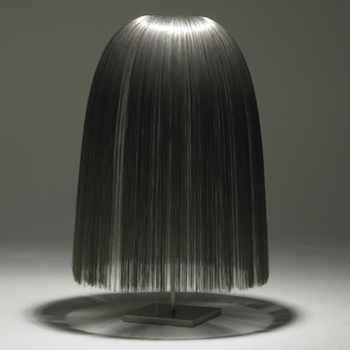By Danielle Arnet

"Willow" sculpture by Harry Bertoia (Photo www.ragoarts.com)
An iconic piece with stainless steel sprays, the "Willow" sculpture by Harry Bertoia sold for $40,260 recently in a Rago Modern auction
Q: I want to sell two Knoll side chairs originally purchased by my father in 1963. Reupholstered twice, they are in very good condition. I've looked on
--Elizabeth
A: One would think that the chair pair, with a respected name like Knoll, a midcentury pedigree and excellent condition, would sell big in a Modern auction or gallery.
But in the world of collecting, common assumptions are sometimes off. The going rate for those handsome chairs is one of those quirks that make collecting so interesting. I'll tell you why.
Founded in 1938 by Hans Knoll in New York City, Knoll is a design firm and manufacturer. The company is behind much of the iconic 20th-century furniture that comes to the secondary market. Many of its products are on permanent exhibit at the
After the founder's death, business continued under the direction of his wife, Florence Knoll. The reader's armchairs are her design. Now based in Pennsylvania, with plants in Toronto and Michigan, the company is still active.
Knoll brought us instantly recognizable furniture, including the Womb chair, the Tulip chair and the Grasshopper lounge, all designed by Eero Saarinen, as well as the Mies van der Rohe Barcelona chair, the Diamond furniture of Harry Bertoia, the Wassily chair by Marcel Breuer, and furniture design classics by Warren Platner, Jens Risom, and, later, George Nakashima, Frank Gehry, Charles Pfister and Robert Venturi -- and many more, as the refrain goes.
Smart collectors know that not all midcentury furniture is iconic. One icon is Saarinen's "Womb" chair. It remains a hot item on the secondary market because it has the double impact of an iconic design and the cachet of a designer name and maker. Every design student and trendsetter recognizes the design when they see it.
Knoll products that sell highest at resale are universally accepted as design stars. But the company also made production furniture for boardrooms and offices, such as the reader's chairs. Since production of those chairs, many knockoffs and like designs have come to market. Goodbye cachet.
Rago Arts in New Jersey (www.ragoarts.com) conducts several Modern auctions each year. The auction house has sold several sets of the chairs.
Rago's Jad Attal called the chairs "a frequently copied modern style club chair." He told us, "In the mid-'90s, a clean pair could sell in the thousands of dollars at auction or in galleries."
Today, however, "a smart buyer watching closely might snag a clean pair for around $900," Attal added. Watching auction databases, we spotted a leather-covered duo that sold recently for $650.
FYI: In "American Insider's Guide to
Q: I believe I have a miniature Newcomb pottery pot. Does it have any value?
--Barbara
A: Newcomb pottery is very desirable: Prices are high and many pieces are in museums. Photos sent are beyond fuzzy, but we'll give it a try.
Newcomb Pottery was founded as an enterprise for women at
Current prices depend on when pieces were made, design, glaze, and which Newcomb student/designer signed the piece.
Drawings indicate that a bottom mark is indeed Newcomb. The artist may be Sarah Irvine, circa 1902-1908. The blue matte glaze is of the period.
It looks like marks are the right stuff. On the website www.artfact.com, an auction results database, we found that in 2003 a Newcomb Pottery vase signed Hoerner brought $5,175 at auction. In 2004, Doyle New York sold a similar piece, artist not identified, for $2,500.
Today, Newcomb at auction brings $1,000 to $10,000, depending on variables.
The small bowl must be evaluated by a specialist in American art pottery. If your objective is to sell, approach any auction house mentioned in this column. Then approach more. Or find an "Antiques Roadshow" specialist/appraiser of American pottery on the website www.pbs.org. This query arrived by regular mail; perhaps a local library can help with computer work.
For a piece as potentially valuable as this, paying for a professional appraisal makes sense.
COLLECTOR QUIZ
Question: Which of the following is NOT characteristic of the American art pottery movement?
a. Pottery companies started small.
b. Pieces are hand-thrown, not molded.
c. Artisans follow European techniques.
d. Pieces have matte or hi-glaze decorations.
e. Pieces are decorated by hand.
Answer: All but c. are true. Source: "Kovel's American Art Pottery" by Ralph and Terry Kovel. Now out of print.
Hobbies & Collecting ...
AUTOS | HOBBIES | EDUCATION | FAMILY | FASHION | FOOD & RECIPES | HOME DECOR | RELATIONSHIPS | PARENTING | PETS | TRAVEL | WOMEN
Collecting - Knockoffs Have Diluted Value of Many Furniture Icons
Article: Copyright © Tribune Media Services